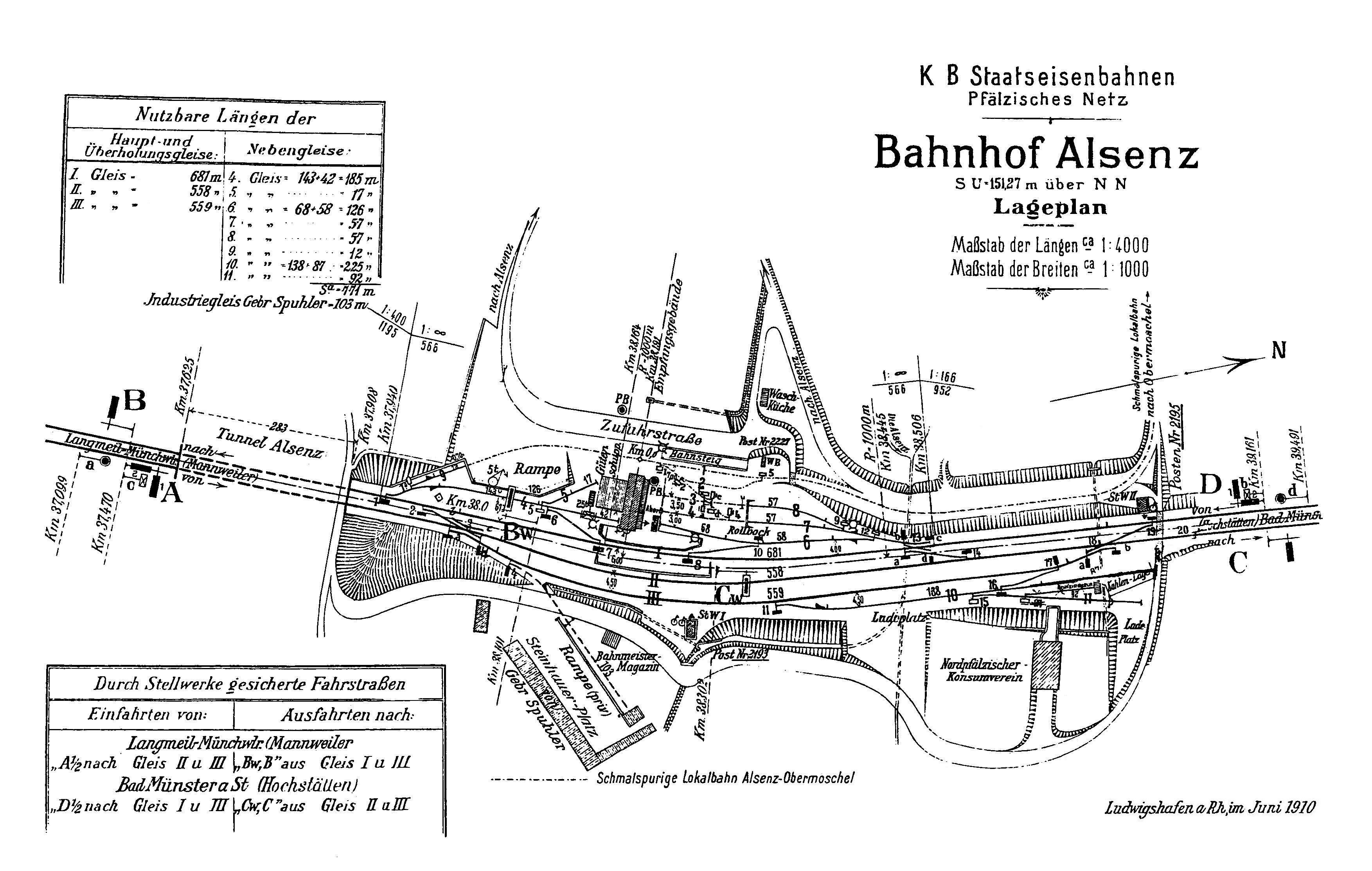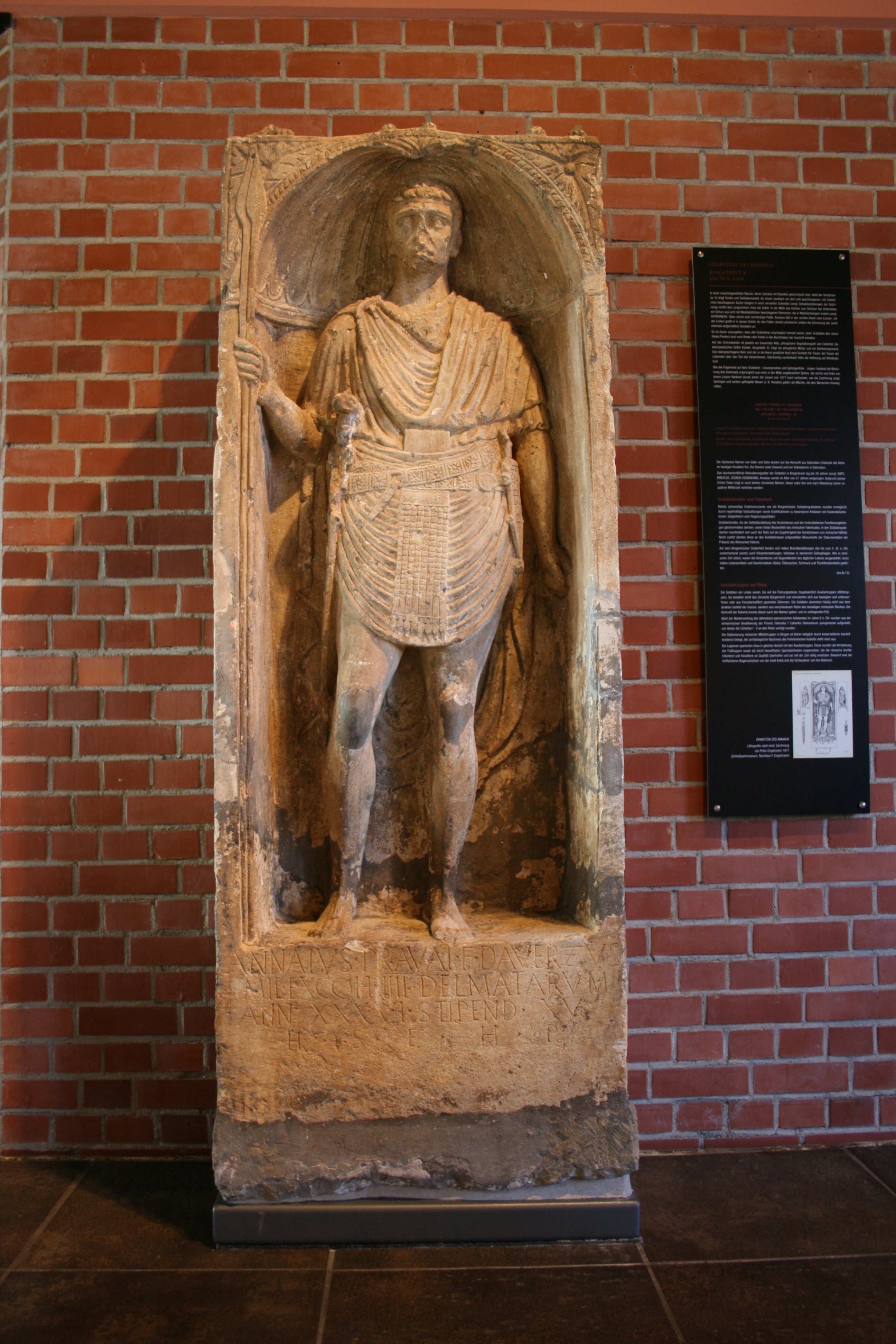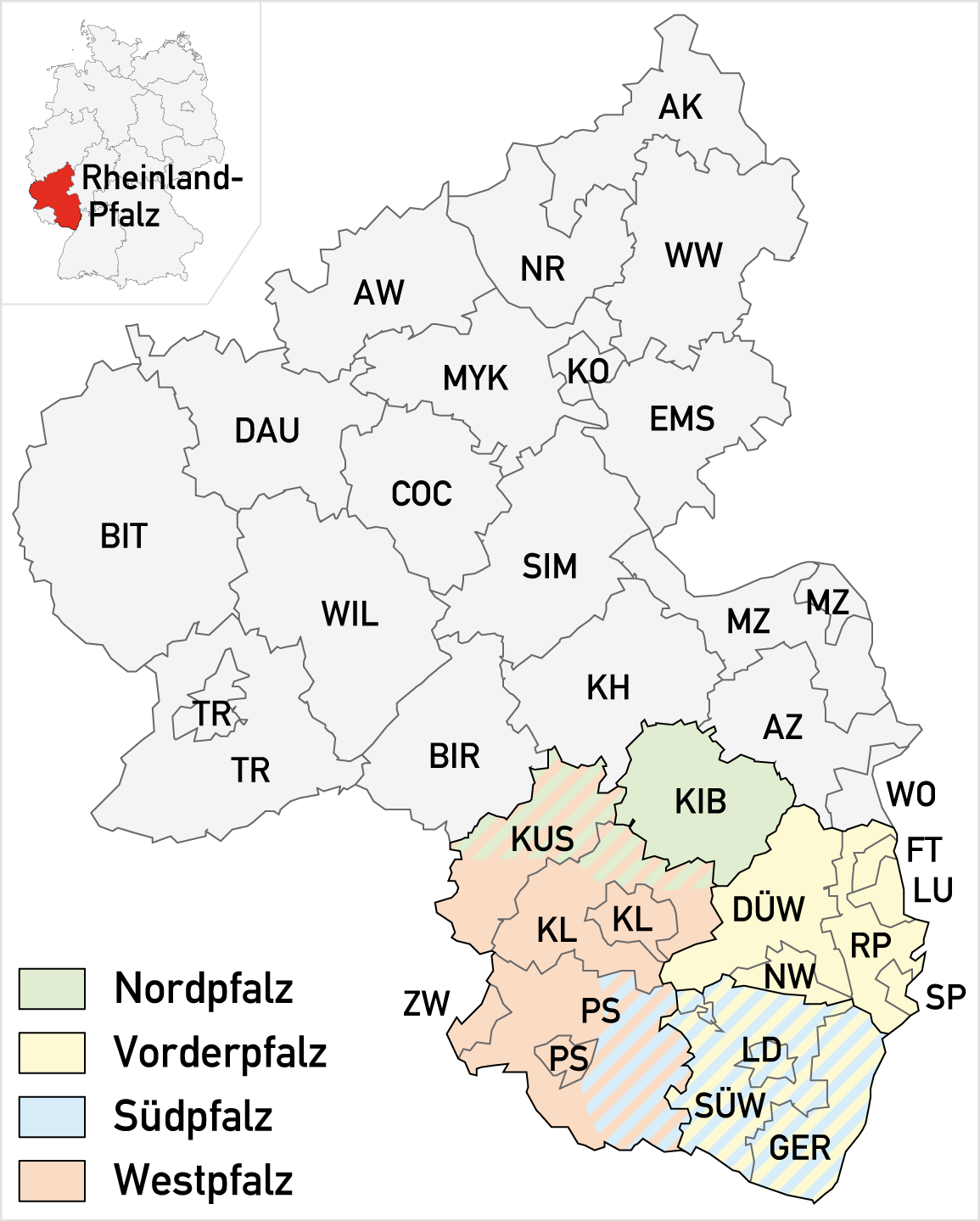|
Alsenz Station
Alsenz station is the station of the town of Alsenz in the German state of Rhineland-Palatinate. Deutsche Bahn classifies it as a category 6 station and it has two platforms. Its address is ''Bahnhofstraße 1''. It is located on the Alsenz Valley Railway (''Alsenztalbahn'', Hochspeyer– Bad Münster) and was opened on 16 May 1871 with the section from Winnweiler to Bad Münster. In 1903, the station became the starting point of a narrow gauge branch line to Obermoschel, which was closed in 1935. Location The station is located within the northeastern built-up area of the community of Alsenz. The local ''Bahnhofstraße'' (station street) runs to its west. History The first campaign for a railway connection to the Alsenz valley (''Alsenztal'') started around 1860. This would have above all created a shorter north-south route for transit traffic that had up to that point been carried through Mainz. After the Hochspeyer–Winnweiler section had already been opened in November ... [...More Info...] [...Related Items...] OR: [Wikipedia] [Google] [Baidu] |
Alsenz
Alsenz () is a municipality in the Donnersbergkreis district, in Rhineland-Palatinate, Germany. Alsenz has an area of 12.88 km2 and a population of 1,647 (as of December 31, 2020). Culture and sights In the centre of the village is the Renaissance village hall (''Rathaus''), built in 1578. The building consists of a bricked lower storey with round arches and timber-framed upper storey. The Palatine Stonemason Museum, (''Pfälzische Steinhauermuseum'') the Museum of Local History (''Museum für Heimatgeschichte'') and the North Palatinate Gallery (''Nordpfalzgalerie'') also use rooms in the village hall. The Nassau-Weilburg district headquarters (''Amtshof''), built around 1780, the 1756 former synagogue and the 18th century Protestant church characterise the village scene. Notable residents * Wilhelm Frick Wilhelm Frick (12 March 1877 – 16 October 1946) was a prominent German politician of the Nazi Party (NSDAP), who served as Reich Minister of the Interior in A ... [...More Info...] [...Related Items...] OR: [Wikipedia] [Google] [Baidu] |
Narrow-gauge Railway
A narrow-gauge railway (narrow-gauge railroad in the US) is a railway with a track gauge narrower than standard-gauge railway, standard . Most narrow-gauge railways are between and . Since narrow-gauge railways are usually built with Minimum railway curve radius, tighter curves, smaller structure gauges, and lighter rails, they can be less costly to build, equip, and operate than standard- or broad-gauge railways (particularly in mountainous or difficult terrain). Lower-cost narrow-gauge railways are often used in mountainous terrain, where engineering savings can be substantial. Lower-cost narrow-gauge railways are often built to serve industries as well as sparsely populated communities where the traffic potential would not justify the cost of a standard- or broad-gauge line. Narrow-gauge railways have specialised use in mines and other environments where a small structure gauge necessitates a small loading gauge. In some countries, narrow gauge is the standard; Japan, Indone ... [...More Info...] [...Related Items...] OR: [Wikipedia] [Google] [Baidu] |
Railway Stations In Rhineland-Palatinate
Rail transport (also known as train transport) is a means of transport that transfers passengers and goods on wheeled vehicles running on rails, which are incorporated in tracks. In contrast to road transport, where the vehicles run on a prepared flat surface, rail vehicles (rolling stock) are directionally guided by the tracks on which they run. Tracks usually consist of steel rails, installed on sleepers (ties) set in ballast, on which the rolling stock, usually fitted with metal wheels, moves. Other variations are also possible, such as "slab track", in which the rails are fastened to a concrete foundation resting on a prepared subsurface. Rolling stock in a rail transport system generally encounters lower frictional resistance than rubber-tyred road vehicles, so passenger and freight cars (carriages and wagons) can be coupled into longer trains. The operation is carried out by a railway company, providing transport between train stations or freight customer facilit ... [...More Info...] [...Related Items...] OR: [Wikipedia] [Google] [Baidu] |
Palatinate (region)
The Palatinate (german: Pfalz; Palatine German: ''Palz'') is a region of Germany. In the Middle Ages it was known as the Rhenish Palatinate (''Rheinpfalz'') and Lower Palatinate (''Unterpfalz''), which strictly speaking designated only the western part of the Electorate of the Palatinate (''Kurfürstentum Pfalz''), as opposed to the Upper Palatinate (''Oberpfalz''). It occupies roughly the southernmost quarter of the German federal state of Rhineland-Palatinate (''Rheinland-Pfalz''), covering an area of with about 1.4 million inhabitants. Its residents are known as Palatines (''Pfälzer''). Geography The Palatinate borders Saarland in the west, historically also comprising the state's Saarpfalz District. In the northwest, the Hunsrück mountain range forms the border with the Rhineland region. The eastern border with Hesse and the Baden region runs along the Upper Rhine river, while the left bank, with Mainz and Worms as well as the Selz basin around Alzey, belong to th ... [...More Info...] [...Related Items...] OR: [Wikipedia] [Google] [Baidu] |
Rollbock
''Rollbocks'', sometimes called transporter trailers, are narrow gauge railway trucks or bogies that allow a standard gauge wagon to 'piggyback' on a narrow-gauge line. The Vevey system enables a coupled train of standard gauge wagons to be automatically loaded or rolled onto Rollbocks, so that the train can then continue through a change of gauge. The system uses a pair of narrow gauge (750 or 1,000 mm) rails laid in a pit that is built in the middle of a standard gauge track, which is elevated by about 30 cm. It allows the ''Rollbock'' bogies to sit underneath the standard gauge tracks and as the ''Rollbock'' train is pulled out of the ''Rollbock'' siding each bogie picks up one axle of a standard gauge wagon as it rises out of the ''Rollbock'' pit. Thus two ''Rollböcke'' are needed for a twin-axle wagon. They were a development of the transporter wagon (''Rollwagen''), designed to keep cost and weight down by avoiding the need for a complete wagon. History The ori ... [...More Info...] [...Related Items...] OR: [Wikipedia] [Google] [Baidu] |
Bingen (Rhein) Hauptbahnhof
Bingen (Rhein) Hauptbahnhof is a railway station in the German city of Bingen am Rhein on the West Rhine Railway. It is located in the borough of Bingerbrück. The station that serves central Bingen is called Bingen Stadt. The station is served by InterCityExpress, Intercity and regional trains. It is a junction station where the Nahe Valley Railway branches of the West Rhine Railway (left bank line). It formerly also included a marshalling yard. The station is classified by Deutsche Bahn as a category 4 station. Location Bingen Hbf is located in the district of Bingerbrück in the city of Bingen am Rhein and extends along the Rhine almost to the Nahe. Bingen Stadt (town) station is less than 2 kilometres to the southeast. The town station is located in the town's centre and its bus station gives better access to the town's bus services than the Hauptbahnhof. Three of the attractions of ''The Industrial Heritage Trail Rhine-Main'' (''Route der Industriekultur Rhein-Main''), wh ... [...More Info...] [...Related Items...] OR: [Wikipedia] [Google] [Baidu] |
Kaiserslautern Hauptbahnhof
Kaiserslautern Hauptbahnhof is a through-station in the German city of Kaiserslautern and one of seven stations in the city. It is a stop on the Rhine-Neckar S-Bahn and Deutsche Bahn’s Intercity-Express network and a hub for all the regional trains of the western Palatinate. On 10 June 2007, the ''Rhealys'' high-speed rail consortium established a service with a stop in Kaiserslautern, reducing travel time to Paris to two and a half hours. In 2003, the station building was renovated and it now houses among other things, a service point and several shops. The station provides step-free access to all platforms. The redesigned Kaiserslautern station forecourt includes a busy bus station, allowing a convenient transfer between bus and rail. Buses run to the University of Kaiserslautern, Betzenberg and the central bus interchanges at Schillerplatz and Rathaus, where there are connections to all bus routes. Prior to the closure of the Einsiedlerhof marshalling yard, Kaiserslautern wa ... [...More Info...] [...Related Items...] OR: [Wikipedia] [Google] [Baidu] |
Western Palatinate
Western Palatinate or West Palatinate (german: Westpfalz) is a sub-region in the west of the Palatinate, a German cultural and historic region in the state of Rhineland-Palatinate. It includes the western part of the Palatine Forest, the central part of the North Palatine Uplands, the West Palatine Moor and the Westrich Plateau. Its former name of "Further Palatinate" (''Hinterpfalz''), which emerged during the time of Bavarian rule in 1816 and was viewed by the local population as very discriminatory, is only commonly used in the Anterior Palatinate (''Vorderpfalz''). The following counties and independent towns or cities lie wholly or partly in the Western Palatinate: * County of Kaiserslautern * City of Kaiserslautern * County of Kusel * Town of Landstuhl * Town of Pirmasens * County of Südwestpfalz * Town of Zweibrücken The county of Donnersbergkreis and the old counties of Rockenhausen and Kirchheimbolanden were also counted as part of the Western Palatinate in th ... [...More Info...] [...Related Items...] OR: [Wikipedia] [Google] [Baidu] |
Deutsche Bundesbahn
The Deutsche Bundesbahn or DB (German Federal Railway) was formed as the state railway of the newly established Federal Republic of Germany (FRG) on 7 September 1949 as a successor of the Deutsche Reichsbahn-Gesellschaft (DRG). The DB remained the state railway of West Germany until after German reunification, when it was merged with the former East German Deutsche Reichsbahn (DR) to form Deutsche Bahn, which came into existence on 1 January 1994. Background After World War II, each of the military governments of the Allied Occupation Zones in Germany were ''de facto'' in charge of the German railways in their respective territories. On 10 October 1946, the railways in the British and American occupation zones formed the ''Deutsche Reichsbahn im Vereinigten Wirtschaftsgebiet'' (German Imperial Railway in the united economic area), while on 25 June 1947, the provinces under French occupation formed the Südwestdeutsche Eisenbahn. With the formation of the FRG these succe ... [...More Info...] [...Related Items...] OR: [Wikipedia] [Google] [Baidu] |
Ludwigshafen
Ludwigshafen, officially Ludwigshafen am Rhein (; meaning " Ludwig's Port upon Rhine"), is a city in the German state of Rhineland-Palatinate, on the river Rhine, opposite Mannheim. With Mannheim, Heidelberg, and the surrounding region, it forms the Rhine Neckar Area. Known primarily as an industrial city, Ludwigshafen is home to BASF, the world's largest chemical producer, and other companies. Among its cultural facilities are the Staatsphilharmonie Rheinland-Pfalz. It is the birthplace and deathplace of the former German chancellor Helmut Kohl. In 2012, Ludwigshafen was classified as a global city with ' Sufficiency' status by the Globalization and World Cities Research Network (GaWC). History Early history In antiquity, Celtic and Germanic tribes settled in the Rhine Neckar area. During the 1st century B.C. the Romans conquered the region, and a Roman auxiliary fort was constructed near the present suburb of Rheingönheim. The Middle Ages saw the foundation of some ... [...More Info...] [...Related Items...] OR: [Wikipedia] [Google] [Baidu] |




